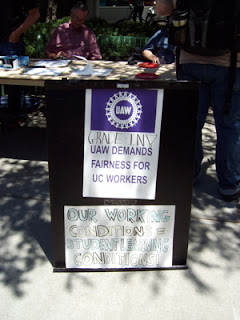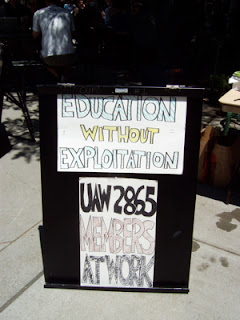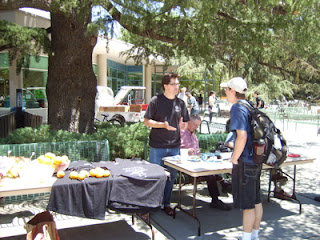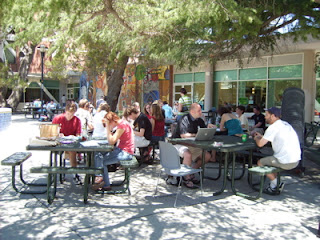(Surf Putah, which you will find in the California friends of our blogroll, is a great site for Yolo Cty. politics. – promoted by Brian Leubitz)
Well, I’ve made the cut, having been linked in the “Yolo Blogs” category over at Republican Yolo County Supervisor Matt Rexroad’s new website (which looks quite nice, really). Along with the link (a good web resource for Yolo County in its own right), Rexroad gave this site this little introduction:
If you want to know what the people at the far end of the spectrum in Davis are doing….surf Putah. I really can’t explain this stuff. Generally, if you find an opinion expressed here Matt Rexroad will be on the other side.
Since I’ve been identified as the far end of the spectrum, I figure that it’s as good a time as any to lay out what us inexplicable far-out Davisites are thinking about Yolo County. Ironically enough, I find myself to the center, or at least in a slightly different direction, from many self-defined “progressives” here in Davis, especially on the issue of development, the axis which city politics seems, rightly or wrongly, to revolve around. Mostly, though, I find that the perpetual battle over political labels to be a fairly useless one, since it assumes a coherent binary political debate, when in fact things tend to be far more complex in real life. I believe that governments ought to balance their budgets responsibly, instead of borrowing and spending with bond measures; am I a conservative? I believe that people generally ought to mind their own business, and that government and religious beliefs are best kept separate where neither can mess the other up; am I a liberal? I believe that all people are created equal, and ought to be treated as such; am I a progressive?
So for the benefit of both Rexroad and those who might follow his link to my site I’ll toss out where this inexplicable far-left blogger would like to see Yolo County headed:
1. Making it possible for Yolo farmers and ranchers to make a decent living, so that they can grow crops instead of subdivisions. The reasons why it is getting harder and harder for small farmers and ranchers to get by are complex, and the roots of the problem more often than not lie well outside of Yolo County. And yet, preserving a healthy and locally-rooted agricultural industry is something that should be central to any vision of a future Yolo County. Protecting farmland from development by easements, or buyouts is one way to help curb development pressure on productive ag land, but it is perhaps more important to ease the market pressures of falling agricultural commodity prices and rising fuel and other operating costs. Encouraging fuel-intensive or alternate fuel usage, aided by ag research over at UC Davis, might help to insulate Yolo agriculture from rising gas prices. Requiring school lunches to preference local farmers and ranchers might help to provide more demand for those products. Teaching gardening in elementary school, as they do at Fairfield Elementary school out in the county, might help to diminish the urban-rural split as well, and give our kids more appreciation for the folks who grow their food.Encouraging new agricultural industries in the county to replace the loss of all those closed tomato canneries in the past decade would help too.
Ultimately, reversing the decades-long national policy of free trade deals that flood domestic markets with foreign imports, and national policies that encourage overproduction are the real key to saving the family farm. Food is one thing, like military technology, that is a bad idea to rely on foreign imports for. We shouldn’t be flying walnuts in all the way from China when we can grow them out perfectly well in Winters.
2. Keeping development off the floodplain, and strengthening the flood control measures where we have already built close to rivers. The Yolo Bypass is a sound approach to the long-term pressures of river systems and seasonal flooding, and Yolo County has been smarter than many counties in this regard. Woodland desperately needs some way of guarding against winter flooding on Cache Creek, and hopefully some hydraulically sound solution will be found in the next couple of years, whether it be stronger levees or some bypass channel upstream of town. While the pressure for more housing is and will continue to be acute because of population growth (more on that below), we need to be steadfast about avoiding Natomas-style floodplain sprawl, because the moment any houses are built there we will collectively be liable for paying for their protection, indefinitely. In places such as West Sacramento, where flooding will always be a problem, we need to make sure that their levees are hardened to withstand severe flooding.
3. Providing adequate housing so that the children of Yolo residents can afford to actually live in their hometowns. This is one area where I part ways with many Davis progressives, in that I do not believe that a no growth or even slow growth model is either smart or just. When a town limits its housing stock like Davis has done, it might preserve the population size of ther town, but the nature of the community cannot but change with the skyrocketing housing prices. As long as people continue to have children, as long as the university increases its student and professorial population (which it will, since it is tied to state demographic growth), and as long as people want to move into this county of ours, we are going to have to have reasonable housing options. Yolo County has both one of the higher rates of growth in the state as well as one of the higher birthrates. All those people are going to have to find somewhere to live.
My sense is that we’d be better off encouraging the cities of Yolo county to start urbanizing in their downtown cores, close to the highways and train stations, to at bare minimum a level of density that our cities reached at the turn of the 19th century (the tallest buildings in most Yolo towns are perversely often the oldest ones). Build up a couple stories, get some people in those downtowns, and then get the downtowns built up along walkable, new urbanist lines, so that people don’t have to drive everywhere just to go about everyday life. This will allow more housing to be efficiently defended by floodwalls where floods threaten, and it should make room for many Yoloites who are currently priced out of even renting here anymore, let alone own houses. Additionally, when suburban housing is built, aim for smaller lots and smaller two story houses the way you used to see in the 20s and 30s, instead of the spread-out ranch tract housing that uses land as if it’s still cheap. Land is expensive, and denser housing makes better and more economical use of that land. And enough already with the huge luxury mcmansion developments for out of towners.
4. Support more small businesses to fulfill city needs, avoid big box megastores. As I wrote during the Measure K debate last November, there is a need for more and better retail in Yolo County, especially here in luxury boutique-saturated downtown Davis, but that we ought to be encouraging small and locally owned businesses to fulfill those needs rather than inviting big box retailers in to suck up the whole market, and siphon that revenue out of the county to some out of state corporate headquarters. Far too often it is posed as a false choice between the status quo and big box megastores, when in fact a third way is possible. One of the problems is that commercial rent is far too high in Davis, but as best as can be done, the city governments and county government should work to ease whatever barriers to starting businesses exist for small local businesses.
5. While this might be seen by some as working at cross-purposes to #4, we really need a living wage for the county, to say nothing of the über-expensive city of Davis as well. People who work in town ought to be able to afford to live in the same communities, or failing that, in the county. While the statewide minimum wage hike of $7.50 goes partway, a hike to a living wage of $10 or higher would help a great deal, and lessen the class segregation that we get when rents get so rediculously high. Living wage ordinances in other towns have shown that they don’t destroy the local economy as predicted, and that the recipients of those wages tend to plough most of that money back into the local economy, creating a virtuous economic cycle. Finally, a living wage is simply the right thing to do, since anybody who works hard every day at a job, any job, deserves the dignity of being able to make ends meet.
6. Along with this, since the National and State governments seem incapable of getting universal health insurance passed, we need to find some way of at least covering children, from prenatal through delivery and child medical care. A significant number of the working poor in Yolo County either are children or have children, and helping to cover the often exorbitant costs of child healthcare would not only go a long way towards lessening that burden on those families (in effect, a net wage raise), it would also help to guarantee that those children got adequate health care, immunizations and so on. This in turn helps to limit problems for the county down the road dealing with epidemics and overtaxed emergency rooms. Disease does not recognize any difference between rich or poor, insured or uninsured, citizen or immigrant; we’ve all seen how quickly a cold or flu can move through an elementary school or a daycare.
Anyone who claims to be in favor of family values ought to be willing to help make sure that people don’t get bankrupted by the costs of giving birth, let alone raising a kid. It is in our best interest personally as well as as a societally to make sure that these kids are covered, at least until the state and federal government get their acts together and get something funded. Since Yolo is a fairly poor county government-wise, this will have to be a fairly bare bones plan without accompanying state funding, not unlike any serious levee solutions. Assemblywoman Wolk, we’re counting on you to help talk some sense into the Governor.
7. More state parks. We have in this county both beautiful hiking up in the hills to the west of us, as well as a beautiful river to the east. Why there aren’t more state parks or recreational infrastructure helping people to get to them is beyond me.
8. The reestablishment of the old interurban train network in the Central Valley. The Capitol Corridor has been a great success since its inception a decade ago, but relatively little work has been done to apply the same logic to the Valley itself, and try and link the cities and towns of the Sacramento Valley together like they once were abnout a century ago, before the rise of auto-fueled sprawl. The old train lines are still there, connecting most cities up and down the valley to Sacramento, and yet they sit virtually unused for commuter traffic. Fixing them up a bit and running basic commuter lines on them would help to take traffic pressure off the highway system, and help us to accomodate what population growth the region will see in the decades to come. It also uses a lot more fuel, which brings us to the next point:
9. Countywide efforts at conservation and alternative energy. As our populations grow, and global warming gives us hotter, dryer summers, we will see increased stresses on our water and electric usage. As peak oil runs hard into increasing global demands for fuel, gasoline and natural gas are going to persistantly rise in price, hurting commuters, farmers and businesses alike. We should be getting ahead of the curve by working to lower our communities’ water and energy footprints, and thus our exposure to price increases and shortages. Having UCD’s stellar environmental engineering research at the ready is a huge advantage; let’s take advantage of it.
10. A justice system that treats all Yolo residents as equal members of their communities, that serves and protects Black and Latino citizens as well as White citizens. Doug Paul Davis over at the Davis Vanguard has done such great reporting on this issue that I won’t try to duplicate it, but rest assured our police forces and justice system need serious revamping on the issues of racial profiling and how we combat crime in general. While gang violence is real, criminalizing an entire neighborhood, as was done in West Sacramento, seems to me to violate the rights of the very citizens that our justice system is ostensibly supposed to protect. Likewise, while out of towners commit crimes in town, treating huge swathes of our community as perpetual suspects does real and lasting harm to the community as a whole. We can do better.
—–
So there you have it, one Yoloite’s “far-left” take on things. While I expect that Matt and I disagree on several of these issues, i’m not sure that he and I are diametrically opposed on all of them. Statewide and nationally, however, I suspect that our political differences are clearer and less common ground possible to reach. I leave the question of whether the above opinions are way off the end of the spectrum up to the reader.
(originally posted at surf putah







